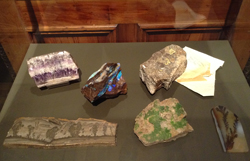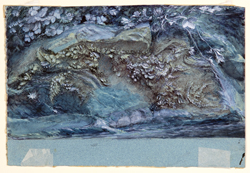
Born 200 years ago, John Ruskin FGS was one of the intellectual giants of 19th century Britain whose lectures, writings, artwork, social work and benefactions continue to have an influence today. What is not widely appreciated today is the considerable influence of geology on Ruskin’s artwork and criticism and his collecting.
The neo-gothic architecture of Two Temple Place (
https://twotempleplace.org/) is an ideal setting for this wonderful exhibition, which celebrates Ruskin's continuing influence and legacy. The panelled rooms are filled with his artwork, encompassing natural history to architecture, as well as work by contemporaries and protégées inspired by him, his social commentary, projects and his zeal as a collector, with some of his minerals from the permanent collections of the Millennium Gallery in Sheffield on display (
http://www.museums-sheffield.org.uk).
 John Ruskin. Study of Moss, Fern and Wood Sorrel, upon a Rocky River Bank 1875-79 Pen, ink, watercolour and bodycolour on paper © Collection of the Guild of St George/Museums Sheffield
John Ruskin. Study of Moss, Fern and Wood Sorrel, upon a Rocky River Bank 1875-79 Pen, ink, watercolour and bodycolour on paper © Collection of the Guild of St George/Museums Sheffield
From childhood Ruskin’s geological interests were stimulated by Scottish landscape. As a precocious teenager he compiled a dictionary of minerals and was fascinated by maps, but was already commenting that it is ‘geology not borders and boundaries that make a map complete’. And, he had geological essays published in Loudon’s Magazine of Natural History before going to Oxford in 1837. Although studying classics, Ruskin came to the attention of William Buckland and made drawings for his lectures. By 1840 Ruskin had met Turner, whose work he greatly admired and whose greatness he championed. It was contemporary criticism of Turner that prompted Ruskin to start writing his highly influential work Modern Painters: their Superiority in the Art of Landscape Painting to the Ancient Masters.
It was the drama of the Swiss alps with their glaciers and visible geological structure that stimulated Ruskin emotionally, spiritually and intellectually. To understand how and why landscape could impact the imagination, Ruskin realised that, like an anatomist, he had to look beneath the surface to its structure and formation. Influenced by the Swiss scientist and alpinist Horace Benedict de Saussure (1740-1799), Ruskin's journal notes, sketches, diagrams and paintings clearly show his understanding of the large-scale structure and cleavage in the form of alpine peaks. By 1856, Ruskin brought together his thoughts, interpretation and illustration of Alpine landscape in volume four of
Modern Painters – Of Mountain Beauty.
Influenced by Buckland, Ruskin was a theological geologist. In lengthy passages of ‘purple prose’ Ruskin relishes the uplifting and divinely inspired vitality and purity of the alpine landscape, as depicted by Turner, compared with the corrupt stagnant decay of lowland landscapes, as painted by the likes of Constable. Whilst Ruskin’s geology never progressed much beyond that of the early decades of the 19th century, he was one of the first great artists to portray the geological anatomy of landscape.
Reviewed by Douglas Palmer
JOHN RUSKIN: THE POWER OF SEEING. A free exhibition at Two Temple Place, London, 26 Jan-22 April, celebrating the cultural and social heritage of the Victorian polymath John Ruskin (1819-1900).
Admission: Free
W: https://twotempleplace.org/exhibitions/john-ruskin/